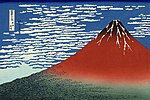13 views of Fuji Terebi, Odaiba, mimics a well-known tradition in Japanese art: collected ukiyoe (wood-block) paintings of Mt. Fuji from multiple locations and angles, in varying weather conditions. This style of art became famous with a collection of 36 prints from artist Katsushika Hokusai around 1830, copied many times by many different artists in many different styles.
|
|
|
|
Here- I add my take on it, with the Fuji Terebi (television) building in Odaiba.

The Fuji Terebi building is huge, bizarre, and dominates the skyline of Odaiba from all angles. It was designed by architect Kenzo Tange who also designed the Tocho- the main twin-towered government building in Shinjuku. On the 25th floor there’s an observation ball which gives the building its distinctive shape, and can be visited for 500 yen.
Fuji Terebi is the funky TV channel in Japan with all the young-people type shows, things like ‘Ai Nori’- the only J-reality show I know of, where young people get on a pink bus and travel round the world together with cameras. ‘Ai Nori’ means ‘love ride’, and the goal of the hip young things on board is to find love amongst each other. When they think they’ve found a willing partner- they ask them to leave the bus together. If the partner agrees, they leave together. If they are rejected, they have to leave the bus alone.
Fuji Terebi sits on a partially artificial island in Tokyo Bay called Odaiba, which means ‘cannon mount’ or ‘cannonade’. It was named after a network of 6 defensive cannon-islands that were built across the Bay in 1853 to protect against foreign invasion, after earlier that year American Colonel Matthew Perry steamed up the Bay with a fleet of black-iron frigates to force open Japan for trade. Japan had been completely unprepared for Perry, and was unable to stop him from landing and demanding delivery of a letter from US President Filmore insisting on free trade. They acquiesced, the letter was received, and when Perry visited again the following year with twice as many ships, he found that most of his conditions had been met, and so Japan opened her ports to trade- beginning the process of Westernization that we see still taking place today.

Fuji Terebi from across Tokyo Bay, close to Tennozu Isle. I walked here after teaching a class in the morning. Tennozu Isle itself is artifical, and built over one of the previous defensive cannon islands.
.

Further round the Bay, flanked by two trucks- this whole area is for shipping and storage of goods, along with a few cement factories.
.

Coming round close to where the Immigration Bureau is, an interesting enough building in its own right, I spy Fuji Terebi in a break between the buildings.
.

In the reflective glass of a warehouse facility.
.

With the Rainbow Bridge spiral access ramp on the left.
.

Through the grill on the South side of the Rainbow Bridge. The bridge shakes a lot with passing traffic, making it quite difficult to get a good shot. Here we’re focused on the grill- would be impossible to jump off any part of the bridge, at least for the tallest two thirds of it.
.

Some kind of boom-arm swings out from the bridge, Fuji Terebi dominates the island- Cannon-mount island number 5 in the water before it.
.

Cannon mount island number 5.
.

From the pit of cannon-mount island No. 5. On the right are stone foundations, and all around are iron-grilled shallow bunkers.
.

From an artificial beach under some pine trees.
.

Fuji Terebi!
.

The observation sphere.
.

From behind, the view from the land-side.
.

The Peace Tower behind Fuji Terebi.
FACTFILE
Location – Odaiba, Tokyo
Entry – None, not enough time, though learned afterwards you can go up to the observation ball for 500 yen.
Facts – Completed in 1997, built partially an artifical island
Architect – Kenzo Tange, the same guy who buil the Tocho in Shinjuku.
Highlights – Crossing the Rainbow Bridge for the first time, learning about the cannon-islands, having an ice-cream on the artificial beach as I cruise towards Fuji TV.
TOKYO
You can see all MJG’s Tokyo content here:
[album id=5 template=compact]



